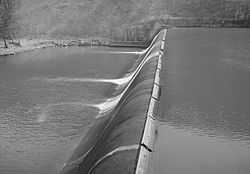Nils F. Ambursen
Nils F. Ambursen (February 6, 1876-January 1958) was a Norwegian-American civil engineer and inventor, best known for his influential dam designs in the early 20th Century.
Born in Fredrikstad and educated at the Civil Engineering College in Skien, Ambursen came to the United States by the age of 21. Working for the B.F. Sturtevant Company in Hyde Park, Boston in 1903, Ambursen developed an innovative concrete slab and buttress dam for an industrial client in Theresa, New York.[1] Ambursen promptly filed a patent on his own behalf and organized the Ambursen Hydraulic Construction Company, based in Boston.
Ambursen's concrete-slab-and-buttress design used far less material than a traditional gravity dam, making it both a significant engineering advance and cost-effective for clients. The record-breaking 41-meter-tall La Prele Dam in remote eastern Wyoming used 43% less concrete than an equivalent concrete gravity dam.[2] The structure allowed an interior hollow under the spillway; the 1907 Bloede's Dam on the Patapsco River housed its hydroelectric power plant inside that hollow and therefore "under water".
From 1903 through 1917 the company used the technique to construct more than 100 dams in North America, most in New England. The company sued to preserve its patents fairly aggressively but with mixed success.[3] In some cases the Ambursen dam became a more generic "Ambursen type", for instance at the 1911 Lock and Dam No. 1 on the Upper Mississippi River. Civil engineer George Freeman received his own November 1912 patent on a modified version of the concrete buttress dam used there.[4]
In 1917 Ambursen left his company, which has continued to bear his name for over a hundred years.[5] Perhaps 50 Ambursen-type dams from the post-World War II era stand in Norway.[6] The highest example, 83 meters tall, is the 1948 Escaba Dam in Argentina.[7]
Work

Ambursen's designs include:
- Warrior Ridge Dam, "the focus of widespread attention in the engineering press", Huntingdon County, Pennsylvania, 1906[8]
- Ellsworth Dam, Ellsworth, Maine, 1907[9]
- Bloede's Dam, Ilchester, Maryland, 1907[10]
- Ashley Dam, Pittsfield, Massachusetts, 1907-1908 (undermined 1909)[11]
- La Prele Dam, near Douglas, Wyoming, 1908-1909 (refurbished in 1977)
- Rapidan Dam, Blue Earth River, Rapidan Township, Minnesota, 1910[12]
- the Mill River Dam, Estacada, Oregon, 1911 (on the National Register of Historic Places)
- Powersite Dam, Forsyth, Missouri, 1911-1913
- Overholser Dam, Oklahoma City, Oklahoma, 1917-1918 (on the National Register of Historic Places)[13][14]
- Remmel Dam, impounding Lake Catherine, Jones Mill, Arkansas, 1924 (on the National Register of Historic Places)[15]
References
- ↑ http://pdfhost.focus.nps.gov/docs/NRHP/Text/01000497.pdf
- ↑ http://213.55.83.52/ebooks/Civil%20Engineering/100394.pdf
- ↑ Building the Ultimate Dam: John S. Eastwood and the Control of Water in the West, by Donald Conrad Jackson, page 295
- ↑ http://lcweb2.loc.gov/pnp/habshaer/mn/mn0300/mn0384/data/mn0384data.pdf
- ↑ http://businessprofiles.com/details/ambursen-company/NY-756
- ↑ http://simscience.org/cracks/advanced/butt_hist1.html
- ↑ http://simscience.org/cracks/advanced/butt_hist1.html
- ↑ http://www.loc.gov/pictures/collection/hh/item/pa3237/
- ↑ Great American Bridges and Dams, by Donald C. Jackson, page 88
- ↑ http://www.dnr.state.md.us/fisheries/bloededam/image/HistoricDocumentation.pdf
- ↑ Engineering news-record, Volume 62, April 1, 1909, page 345
- ↑ Blue Earth County, Minnesota, by Blue Earth County Historical Society, page 86
- ↑ http://www.okc.gov/lakes/overholser_dam.html
- ↑ http://pdfhost.focus.nps.gov/docs/NRHP/Text/07000518.pdf
- ↑ http://encyclopediaofarkansas.net/encyclopedia/entry-detail.aspx?entryID=2319